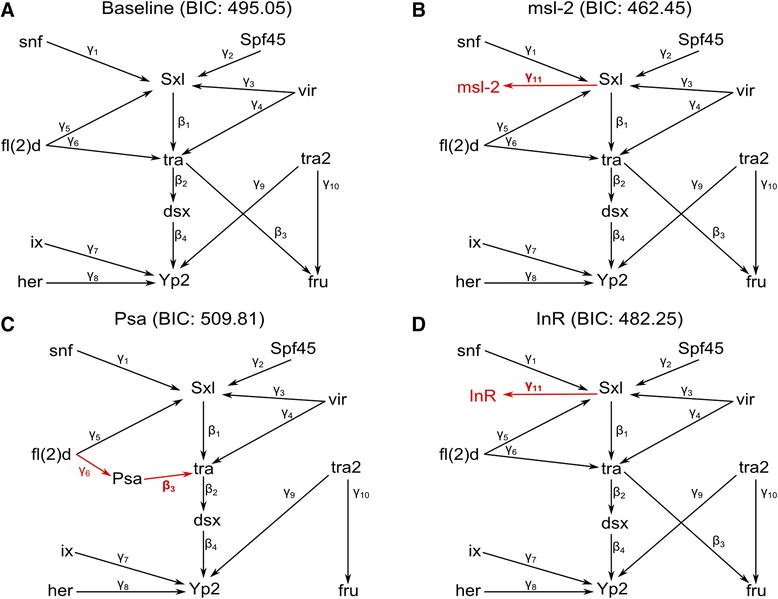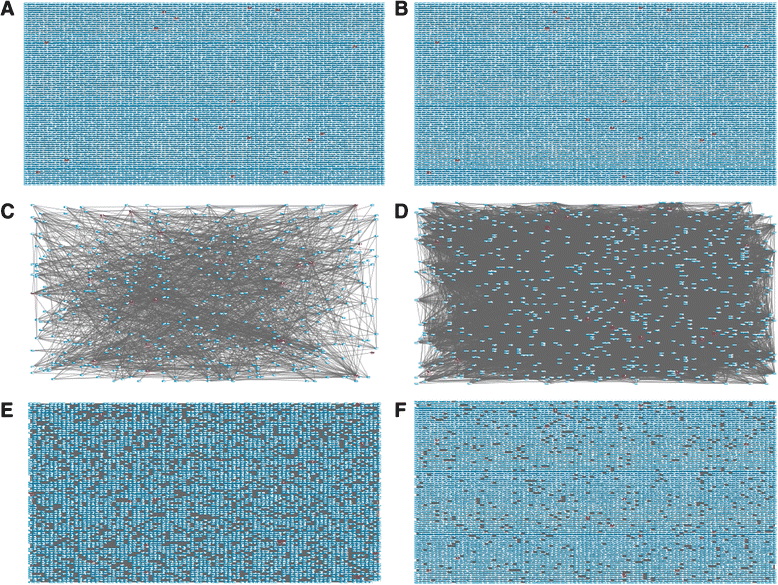The Wright stuff: reimagining path analysis reveals novel components of the sex determination hierarchy in Drosophila melanogaster
- PMID: 26335107
- PMCID: PMC4558766
- DOI: 10.1186/s12918-015-0200-0
The Wright stuff: reimagining path analysis reveals novel components of the sex determination hierarchy in Drosophila melanogaster
Abstract
Background: The Drosophila sex determination hierarchy is a classic example of a transcriptional regulatory hierarchy, with sex-specific isoforms regulating morphology and behavior. We use a structural equation modeling approach, leveraging natural genetic variation from two studies on Drosophila female head tissues--DSPR collection (596 F1-hybrids from crosses between DSPR sub-populations) and CEGS population (75 F1-hybrids from crosses between DGRP/Winters lines to a reference strain w1118)--to expand understanding of the sex hierarchy gene regulatory network (GRN). This approach is completely generalizable to any natural population, including humans.
Results: We expanded the sex hierarchy GRN adding novel links among genes, including a link from fruitless (fru) to Sex-lethal (Sxl) identified in both populations. This link is further supported by the presence of fru binding sites in the Sxl locus. 754 candidate genes were added to the pathway, including the splicing factors male-specific lethal 2 and Rm62 as downstream targets of Sxl which are well-supported links in males. Independent studies of doublesex and transformer mutants support many additions, including evidence for a link between the sex hierarchy and metabolism, via Insulin-like receptor.
Conclusions: The genes added in the CEGS population were enriched for genes with sex-biased splicing and components of the spliceosome. A common goal of molecular biologists is to expand understanding about regulatory interactions among genes. Using natural alleles we can not only identify novel relationships, but using supervised approaches can order genes into a regulatory hierarchy. Combining these results with independent large effect mutation studies, allows clear candidates for detailed molecular follow-up to emerge.
Figures





Similar articles
-
m6A potentiates Sxl alternative pre-mRNA splicing for robust Drosophila sex determination.Nature. 2016 Dec 8;540(7632):301-304. doi: 10.1038/nature20577. Epub 2016 Nov 30. Nature. 2016. PMID: 27919081
-
Molecular genetic dissection of the sex-specific and vital functions of the Drosophila melanogaster sex determination gene fruitless.Genetics. 2001 Aug;158(4):1569-95. doi: 10.1093/genetics/158.4.1569. Genetics. 2001. PMID: 11514448 Free PMC article.
-
Chinmo prevents transformer alternative splicing to maintain male sex identity.PLoS Genet. 2018 Feb 1;14(2):e1007203. doi: 10.1371/journal.pgen.1007203. eCollection 2018 Feb. PLoS Genet. 2018. PMID: 29389999 Free PMC article.
-
Masters change, slaves remain.Bioessays. 2003 Jan;25(1):1-4. doi: 10.1002/bies.10207. Bioessays. 2003. PMID: 12508274 Review.
-
The autoregulatory loop: A common mechanism of regulation of key sex determining genes in insects.J Biosci. 2016 Jun;41(2):283-94. doi: 10.1007/s12038-016-9609-x. J Biosci. 2016. PMID: 27240989 Review.
Cited by
-
Neurons That Underlie Drosophila melanogaster Reproductive Behaviors: Detection of a Large Male-Bias in Gene Expression in fruitless-Expressing Neurons.G3 (Bethesda). 2016 Aug 9;6(8):2455-65. doi: 10.1534/g3.115.019265. G3 (Bethesda). 2016. PMID: 27247289 Free PMC article.
-
Analysis of Gene Expression Variance in Schizophrenia Using Structural Equation Modeling.Front Mol Neurosci. 2018 Jun 11;11:192. doi: 10.3389/fnmol.2018.00192. eCollection 2018. Front Mol Neurosci. 2018. PMID: 29942251 Free PMC article.
-
Female-biased upregulation of insulin pathway activity mediates the sex difference in Drosophila body size plasticity.Elife. 2021 Jan 15;10:e58341. doi: 10.7554/eLife.58341. Elife. 2021. PMID: 33448263 Free PMC article.
-
Understanding the metabolome and metagenome as extended phenotypes: The next frontier in macroalgae domestication and improvement.J World Aquac Soc. 2021 Oct;52(5):1009-1030. doi: 10.1111/jwas.12782. Epub 2021 Mar 24. J World Aquac Soc. 2021. PMID: 34732977 Free PMC article.
-
Interplay between sex determination cascade and major signaling pathways during Drosophila eye development: Perspectives for future research.Dev Biol. 2021 Aug;476:41-52. doi: 10.1016/j.ydbio.2021.03.005. Epub 2021 Mar 18. Dev Biol. 2021. PMID: 33745943 Free PMC article. Review.
References
Publication types
MeSH terms
Substances
Associated data
- Actions
Grants and funding
LinkOut - more resources
Full Text Sources
Other Literature Sources
Molecular Biology Databases
Miscellaneous

